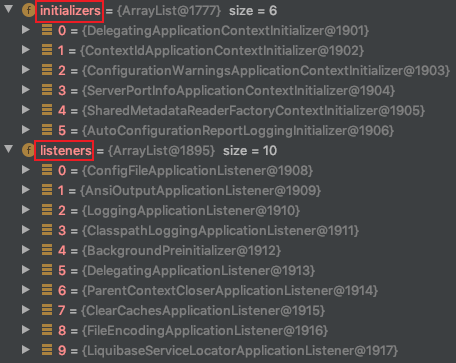SpringBoot1.x 启动配置原理 和 自定义starter
启动配置原理
启动过程主要为:
new SpringApplication(sources)创建 SpringApplication 对象springApplication.run()运行Spring应用程序,创建并刷新一个新的应用环境- 整个过程使用了事件监听机制
创建 SpringApplication 对象
SpringApplication.run(StartStarterApplication.class, args);
public static ConfigurableApplicationContext run(Object[] sources, String[] args) {
return new SpringApplication(sources).run(args);
}
public SpringApplication(Object... sources) {
initialize(sources);
}
private void initialize(Object[] sources) {
// 保存主配置类信息
if (sources != null && sources.length > 0) {
this.sources.addAll(Arrays.asList(sources));
}
// 判断当前是否是一个 Web App
this.webEnvironment = deduceWebEnvironment();
// 从类路径下找到 META_INF/spring.factories 配置文件的 ApplicationContextInitializer,然后保存起来
setInitializers((Collection) getSpringFactoriesInstances(ApplicationContextInitializer.class));
// 从类路径下找到 META_INF/spring.factories 配置文件的 ApplicationListener,然后保存起来
setListeners((Collection) getSpringFactoriesInstances(ApplicationListener.class));
// 从多个配置类中找到有 main() 的主配置类
this.mainApplicationClass = deduceMainApplicationClass();
}

运行Spring应用程序,创建并刷新一个新的应用环境
public ConfigurableApplicationContext run(String... args) {
StopWatch stopWatch = new StopWatch();
stopWatch.start();
ConfigurableApplicationContext context = null;
FailureAnalyzers analyzers = null;
configureHeadlessProperty();
// 从类路径下的 META_INF/spring.factories 中获取 SpringApplicationRunListeners
SpringApplicationRunListeners listeners = getRunListeners(args);
// 回调所有的 SpringApplicationRunListener.starting()
listeners.starting();
try {
// 封装命令行参数
ApplicationArguments applicationArguments = new DefaultApplicationArguments(args);
// 准备环境
// 准备环境完成后,回调 SpringApplicationRunListener.environmentPrepared() 表示环境准备完成
ConfigurableEnvironment environment = prepareEnvironment(listeners, applicationArguments);
// 打印 Spring 标志
Banner printedBanner = printBanner(environment);
// 创建 ApplicationContext,决定创建 web 的ioc,还是普通的 ioc
context = createApplicationContext();
analyzers = new FailureAnalyzers(context);
// 准备上下文环境,将 environment 保存到 ioc 中,而且调用 applyInitializers()
// 这个方法将 回调之前保存的所有的 ApplicationContextInitializer 的 initialize()
// 和 回调之前保存的所有的 SpringApplicationRunListener 的 contextPrepared()
// 准备上下文环境完成后,回调之前保存的所有的 SpringApplicationRunListener 的 contextLoaded()
// 控制台打印:使用 PID 6894 在 192.168.0.103 上启动 主配置类
prepareContext(context, environment, listeners, applicationArguments, printedBanner);
// 刷新容器,即 ioc 容器初始化,如果是 web app 还会创建嵌入式的 Tomcat
refreshContext(context);
// 从 ioc 容器中获取所有的 ApplicationRunner 和 CommandLineRunner 进行回调
afterRefresh(context, applicationArguments);
// 所有的 SpringApplicationRunListener 回调 finished()
listeners.finished(context, null);
stopWatch.stop();
if (this.logStartupInfo) {
new StartupInfoLogger(this.mainApplicationClass).logStarted(getApplicationLog(), stopWatch);
}
// 整个 SpringBoot 应用启动完成以后返回启动的 ioc 容器
return context;
}
catch (Throwable ex) {
handleRunFailure(context, listeners, analyzers, ex);
throw new IllegalStateException(ex);
}
}
事件监听机制
ApplicationContextInitializer、SpringApplicationRunListener 配置在 META-INF/spring.factories 中。
ApplicationRunner、CommandLineRunner 放在 ioc 容器中。
HelloApplicationContextInitializer:
public class HelloApplicationContextInitializer implements ApplicationContextInitializer<ConfigurableApplicationContext> {
@Override
public void initialize(ConfigurableApplicationContext applicationContext) {
System.out.println("ApplicationContextInitializer...initialize..."+applicationContext);
}
}
HelloSpringApplicationRunListener:
public class HelloSpringApplicationRunListener implements SpringApplicationRunListener {
// 必须有一个构造器
public HelloSpringApplicationRunListener(SpringApplication application, String[] arg) {
}
@Override
public void starting() {
System.out.println("SpringApplicationRunListener...starting...");
}
@Override
public void environmentPrepared(ConfigurableEnvironment environment) {
System.out.println("SpringApplicationRunListener...environmentPrepared.." + environment);
Object o = environment.getSystemProperties().get("os.name");
System.out.println("SpringApplicationRunListener...environmentPrepared.. os.name "+o);
}
@Override
public void contextPrepared(ConfigurableApplicationContext context) {
System.out.println("SpringApplicationRunListener...contextPrepared...");
}
@Override
public void contextLoaded(ConfigurableApplicationContext context) {
System.out.println("SpringApplicationRunListener...contextLoaded...");
}
@Override
public void finished(ConfigurableApplicationContext context, Throwable exception) {
System.out.println("SpringApplicationRunListener...finished...");
}
}
将它们配置在 META-INF/spring.factories 中:
src/main/resources/META-INF/spring.factories
org.springframework.context.ApplicationContextInitializer=
cn.parzulpan.listener.HelloApplicationContextInitializer
org.springframework.boot.SpringApplicationRunListener=
cn.parzulpan.listener.HelloSpringApplicationRunListener
HelloApplicationRunner:
@Component
public class HelloApplicationRunner implements ApplicationRunner {
@Override
public void run(ApplicationArguments args) throws Exception {
System.out.println("ApplicationRunner...run...." + args);
}
}
HelloCommandLineRunner:
@Component
public class HelloCommandLineRunner implements CommandLineRunner {
@Override
public void run(String... args) throws Exception {
System.out.println("CommandLineRunner...run..."+ Arrays.asList(args));
}
}
将它们放置在 ioc 容器中。
运行主配置类,观察打印输出,可以得到上面的结论。
自定义 starter
SpringBoot 最大的特点就是引入非常多的场景启动器,想使用那个场景就可以直接整合。
它也支持自定义场景启动器,比如 mybatis-spring-boot-starter。
编写自动配置需要的必有项:
@Configuration // 指定这个类是一个配置类
@ConditionalOnXXX // 在指定条件成立的情况下自动配置类生效
@AutoConfigureAfter // 指定自动配置类的顺序
@Bean // 给容器中添加组件
@ConfigurationPropertie // 结合相关 xxxProperties 类来绑定相关的配置
@EnableConfigurationProperties // 让 xxxProperties 生效并加入到容器中
自动配置类要能加载将需要启动就加载的自动配置类,配置在 META‐INF/spring.factories 中
# Auto Configure
org.springframework.boot.autoconfigure.EnableAutoConfiguration=
org.mybatis.spring.boot.autoconfigure.MybatisAutoConfiguration
模式总结:
- 启动器只用来做依赖导入
xx-spring-boot-starter - 编写一个自动配置模块
xx-spring-boot-starter-autoconfigurer - 启动器依赖自动配置模块,别人使用只需要引入启动器
- 官方命名空间:
spring-boot-starter-模块名, 自定义命名空间:模块名-spring-boot-starter
自定义步骤
前期准备:创建一个空项目 custom-starter ,向其加入一个 Maven 工厂
parzulpan-spring-boot-starter 模块,在加入一个 springboot 类型的 parzulpan-spring-boot-starte 模块。
启动器模块:
<?xml version="1.0" encoding="UTF-8"?>
<project xmlns="http://maven.apache.org/POM/4.0.0"
xmlns:xsi="http://www.w3.org/2001/XMLSchema-instance"
xsi:schemaLocation="http://maven.apache.org/POM/4.0.0 http://maven.apache.org/xsd/maven-4.0.0.xsd">
<modelVersion>4.0.0</modelVersion>
<groupId>cn.parzulpan</groupId>
<artifactId>parzulpan-spring-boot-starter</artifactId>
<version>1.0-SNAPSHOT</version>
<!-- 启动器 -->
<dependencies>
<!-- 依赖自动配置模块 -->
<dependency>
<groupId>cn.parzulpan</groupId>
<artifactId>parzulpan-spring-boot-starter-configurer</artifactId>
<version>0.0.1-SNAPSHOT</version>
</dependency>
</dependencies>
</project>
自动配置模块:
<?xml version="1.0" encoding="UTF-8"?>
<project xmlns="http://maven.apache.org/POM/4.0.0" xmlns:xsi="http://www.w3.org/2001/XMLSchema-instance"
xsi:schemaLocation="http://maven.apache.org/POM/4.0.0 https://maven.apache.org/xsd/maven-4.0.0.xsd">
<modelVersion>4.0.0</modelVersion>
<parent>
<groupId>org.springframework.boot</groupId>
<artifactId>spring-boot-starter-parent</artifactId>
<version>1.5.22.RELEASE</version>
<relativePath/> <!-- lookup parent from repository -->
</parent>
<groupId>cn.parzulpan</groupId>
<artifactId>parzulpan-spring-boot-starter-configurer</artifactId>
<version>0.0.1-SNAPSHOT</version>
<name>parzulpan-spring-boot-starter-configurer</name>
<description>parzulpan starter configurer</description>
<properties>
<project.build.sourceEncoding>UTF‐8</project.build.sourceEncoding>
<project.reporting.outputEncoding>UTF‐8</project.reporting.outputEncoding>
<java.version>1.8</java.version>
</properties>
<dependencies>
<!-- 引入spring‐boot‐starter,它是所有 starter 的基本配置 -->
<dependency>
<groupId>org.springframework.boot</groupId>
<artifactId>spring-boot-starter</artifactId>
</dependency>
</dependencies>
</project>
编写业务类 HelloService:
package cn.parzulpan;
/**
* @Author : parzulpan
* @Time : 2020-12
* @Desc : HelloService
*/
public class HelloService {
HelloServiceProperties helloServiceProperties;
public HelloServiceProperties getHelloServiceProperties() {
return helloServiceProperties;
}
public void setHelloServiceProperties(HelloServiceProperties helloServiceProperties) {
this.helloServiceProperties = helloServiceProperties;
}
public String sayHelloName(String name) {
return helloServiceProperties.getPrefix() + " - " + name + " - " + helloServiceProperties.getSuffix();
}
}
编写属性类 HelloServiceProperties:
/**
* @Author : parzulpan
* @Time : 2020-12
* @Desc : HelloService 属性类
*/
@ConfigurationProperties(prefix = "parzulpan.hello")
public class HelloServiceProperties {
private String prefix; // 前置语
private String suffix; // 后置语
public String getPrefix() {
return prefix;
}
public void setPrefix(String prefix) {
this.prefix = prefix;
}
public String getSuffix() {
return suffix;
}
public void setSuffix(String suffix) {
this.suffix = suffix;
}
}
编写配置文件 src/main/resources/META-INF/spring.factories:
org.springframework.boot.autoconfigure.EnableAutoConfiguration=
cn.parzulpan.HelloServiceAutoConfiguration
编写自动配置类 HelloServiceAutoConfiguration:
/**
* @Author : parzulpan
* @Time : 2020-12
* @Desc : HelloService 自动配置类
*/
@Configuration
@ConditionalOnWebApplication // web app 才有效
@EnableConfigurationProperties(HelloServiceProperties.class) // 让 HelloServiceProperties 生效并加入到容器中
public class HelloServiceAutoConfiguration {
@Autowired
HelloServiceProperties helloServiceProperties;
@Bean
public HelloService helloService() {
HelloService helloService = new HelloService();
helloService.setHelloServiceProperties(helloServiceProperties);
return helloService;
}
}
将这两个模块分别 install 到本地,然后测试使用,创建一个 SpringBoot Web 项目 custom-starter-test ,引入自定义 starter。测试源码
<!-- 引入自定义 starter -->
<dependency>
<groupId>cn.parzulpan</groupId>
<artifactId>parzulpan-spring-boot-starter</artifactId>
<version>1.0-SNAPSHOT</version>
</dependency>
编写配置文件 application.properties:
parzulpan.hello.prefix=PARZULPAN
parzulpan.hello.suffix=HELLO WORLD
编写控制类:
/**
* @Author : parzulpan
* @Time : 2020-12
* @Desc :
*/
@RestController
public class HelloController {
@Autowired
HelloService helloService;
// http://localhost:8080/hello
@GetMapping("/hello")
public String hello() {
return helloService.sayHelloName("curry");
}
}